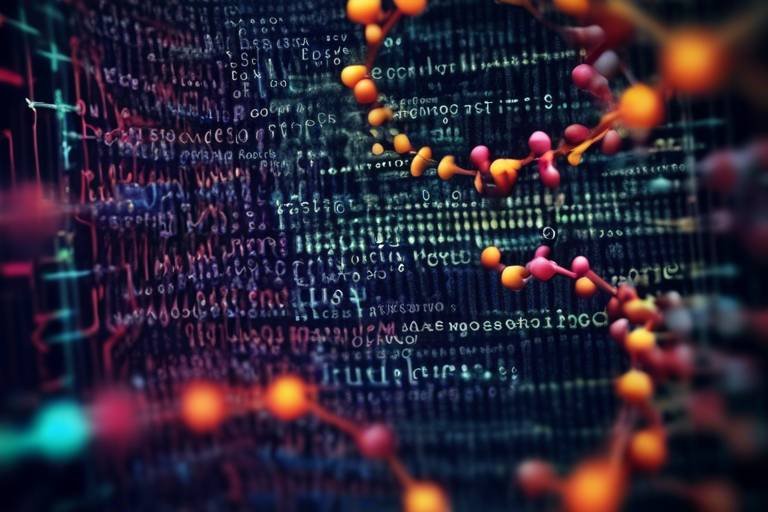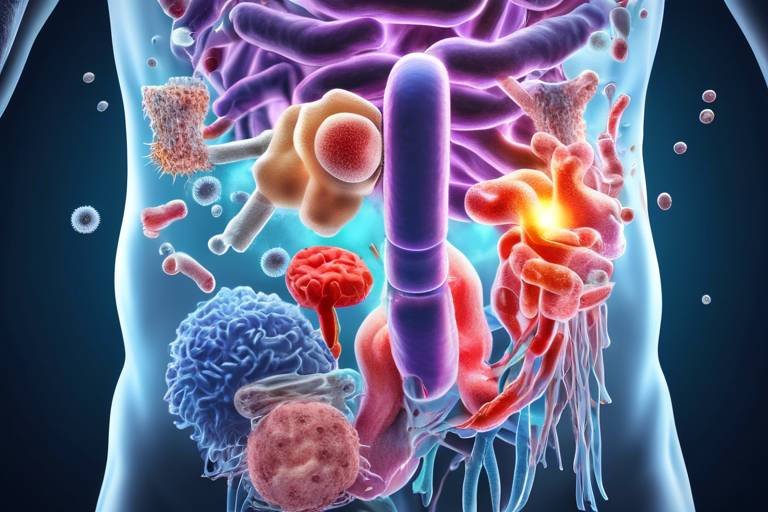Understanding Recent Advances in Forensic Science
In recent years, forensic science has witnessed a remarkable transformation, fueled by innovations that push the boundaries of traditional investigative methods. The integration of advanced technologies and techniques has not only enhanced the accuracy of criminal investigations but also significantly influenced legal proceedings. Imagine a world where cold cases that have stumped investigators for decades are suddenly solved, thanks to groundbreaking advancements in DNA analysis or digital forensics. This article delves into the latest developments in forensic science, highlighting innovative techniques, technologies, and their implications for criminal investigations and legal proceedings.
Recent advancements in DNA analysis have revolutionized forensic science, allowing for more accurate identification of suspects and victims, as well as the ability to solve cold cases previously thought unsolvable. Techniques such as Next-Generation Sequencing (NGS) and Single Nucleotide Polymorphism (SNP) analysis have enabled forensic experts to extract and analyze DNA from even the smallest biological samples. This has proven invaluable in cases where traditional methods fall short, such as when samples are degraded or contaminated. Furthermore, the use of familial DNA searches has opened up new avenues for solving crimes by linking suspects to relatives in DNA databases, thereby expanding the scope of investigations.
As technology evolves, digital forensics has become increasingly important. This field focuses on recovering and analyzing digital evidence from devices such as computers and smartphones in criminal investigations. With the proliferation of digital devices, the amount of data available for analysis has skyrocketed. Forensic experts now employ sophisticated tools to extract information from devices, including deleted files and hidden data. This is crucial not only for solving crimes but also for establishing timelines and corroborating witness statements.
With the rise of cybercrime, forensic techniques must adapt to address the unique challenges posed by the digital landscape. Cybercriminals are becoming more sophisticated, making it essential for forensic investigators to stay ahead of the curve. Tools such as network analysis software and malware analysis tools are now commonplace in cybercrime investigations. These technologies allow forensic experts to effectively gather evidence from digital platforms, track down perpetrators, and ultimately bring them to justice.
Data recovery techniques are critical in digital forensics. Experts use various methods to retrieve lost or deleted data, which can be pivotal in supporting investigations and legal proceedings. Techniques such as file carving, disk imaging, and memory analysis enable forensic professionals to recover valuable information that could otherwise remain hidden. This not only aids in criminal investigations but also helps in civil cases where data integrity is in question.
Maintaining the chain of custody is vital for the integrity of digital evidence. This process ensures that evidence remains untampered and admissible in court. Best practices include meticulous documentation of who accessed the evidence, how it was handled, and where it was stored. By adhering to these protocols, forensic experts can provide credible evidence that withstands scrutiny in legal proceedings, ensuring that justice is served.
Innovative technologies are transforming forensic science in ways we could only dream of a few years ago. Cutting-edge tools such as 3D scanning, virtual reality, and artificial intelligence are now being utilized in crime scene analysis and evidence presentation. For instance, 3D scanning allows investigators to create detailed digital models of crime scenes, preserving them for future analysis and courtroom presentations. Virtual reality can immerse jurors in the crime scene, providing them with a clearer understanding of the events that transpired.
Forensic toxicology plays a crucial role in understanding substance-related crimes. Recent developments in toxicology testing have enhanced the accuracy and speed of analyses, allowing forensic experts to determine the cause of death or impairment in legal cases more effectively. New methodologies, such as liquid chromatography-mass spectrometry (LC-MS), have revolutionized drug testing, enabling the detection of a wider range of substances in biological samples.
New methodologies in drug testing have emerged, enhancing the accuracy and speed of toxicological analysis. Techniques such as high-resolution mass spectrometry allow forensic toxicologists to identify and quantify drugs with unprecedented precision. These advancements not only improve the reliability of test results but also expedite the process, ensuring timely justice for victims and accountability for offenders.
Alcohol testing methods have evolved significantly, providing more reliable results. Techniques such as breath analysis and blood testing have been refined to ensure accuracy in measuring blood alcohol content (BAC) in various scenarios, including driving under the influence cases. With the introduction of portable breathalyzers that provide instant results, law enforcement can act swiftly, making our roads safer.
- What are the latest advancements in DNA analysis? Recent advancements include Next-Generation Sequencing and familial DNA searches, which enhance the accuracy of suspect identification.
- How is digital forensics evolving? Digital forensics is evolving with sophisticated tools for data recovery and analysis, crucial for solving modern crimes.
- What role does forensic toxicology play in investigations? Forensic toxicology helps determine the cause of death or impairment by analyzing substances in biological samples.
- How do emerging technologies impact forensic science? Technologies like 3D scanning and artificial intelligence are transforming crime scene analysis and evidence presentation.

DNA Analysis Techniques
Recent advancements in DNA analysis have revolutionized forensic science, making it a cornerstone of modern criminal investigations. Imagine a world where a single drop of blood or a strand of hair can unravel the complexities of a crime scene. With cutting-edge techniques, forensic experts can now identify suspects and victims with astonishing accuracy, often turning the tide in cases that have remained cold for years. This evolution in DNA technology not only aids in solving crimes but also helps exonerate the innocent, showcasing the profound impact these advancements have on the justice system.
One of the most significant breakthroughs in DNA analysis is the development of Next Generation Sequencing (NGS). This method allows scientists to sequence entire genomes quickly and efficiently, providing a comprehensive view of genetic information. Unlike traditional methods that focus on specific regions of DNA, NGS can analyze millions of fragments simultaneously, leading to more detailed and reliable results. This is particularly useful in complex cases where multiple individuals' DNA might be present, such as in a sexual assault investigation.
Additionally, the field has seen improvements in Polymerase Chain Reaction (PCR)Real-Time PCR, allow for the monitoring of the amplification process in real-time, providing more accurate results and reducing the time needed for analysis. This speed is crucial in urgent investigations where timely evidence can make all the difference.
Moreover, forensic scientists are now employing Y-chromosome analysis and mitochondrial DNA testing to further refine their investigative techniques. Y-chromosome analysis is particularly useful in cases where male DNA is mixed with female DNA, as it can isolate paternal lineage. On the other hand, mitochondrial DNA testing is invaluable in identifying remains, especially in cases involving skeletal or degraded samples since mitochondrial DNA is more abundant and can be inherited from the mother.
To illustrate the impact of these advanced techniques, consider the following table that summarizes key DNA analysis methods and their applications:
| Technique | Application |
|---|---|
| Next Generation Sequencing (NGS) | Comprehensive genome analysis for complex cases |
| Polymerase Chain Reaction (PCR) | Amplification of small DNA samples |
| Y-chromosome Analysis | Isolation of male lineage in mixed DNA |
| Mitochondrial DNA Testing | Identification of remains from degraded samples |
These advancements in DNA analysis techniques not only enhance the accuracy of forensic investigations but also pave the way for new possibilities in solving crimes. As technology continues to evolve, we can expect even more innovative methods to emerge, further solidifying DNA analysis as an indispensable tool in the pursuit of justice.

Digital Forensics
In today's tech-savvy world, has emerged as a pivotal field within forensic science, evolving rapidly alongside the advancements in technology. As our lives become increasingly intertwined with digital devices, the need for effective methods to recover and analyze digital evidence has never been more crucial. Imagine a crime scene where traditional evidence is scarce, yet a suspect's smartphone holds the key to unraveling the mystery. That's where digital forensics steps in, transforming the way we approach criminal investigations.
Digital forensics encompasses a variety of techniques and methodologies aimed at extracting and preserving data from electronic devices. This can include anything from computers and smartphones to cloud storage systems. The process involves a meticulous approach to ensure that evidence is collected in a way that maintains its integrity and validity. For instance, forensic experts often utilize specialized software tools to create a bit-for-bit copy of a hard drive, allowing them to analyze the data without altering the original evidence. This practice is fundamental in ensuring that any findings can be presented in court without question.
As we delve deeper into the realm of digital forensics, we encounter several critical components that define this field:
- Data Recovery: Experts use advanced techniques to recover deleted or corrupted files, which can be instrumental in piecing together a timeline of events related to a crime.
- Evidence Analysis: Once data is recovered, forensic analysts sift through the information to identify relevant evidence, such as emails, messages, and files that could implicate a suspect.
- Report Generation: After analysis, professionals compile their findings into comprehensive reports that can be used in legal proceedings, ensuring that all evidence is clearly documented and presented.
Moreover, the rise of social media and online platforms has added layers of complexity to digital investigations. Forensic experts must now navigate through vast amounts of data, including posts, images, and interactions that can provide critical insights into a suspect's behavior and connections. The ability to analyze this digital footprint can often make or break a case, revealing patterns or links that might otherwise go unnoticed.
However, with great power comes great responsibility. The handling of digital evidence must adhere to strict protocols to maintain the chain of custody. This ensures that every piece of evidence collected can be accounted for and is admissible in court. Any breach in this protocol could render the evidence useless, jeopardizing the entire investigation. Therefore, forensic teams are trained rigorously in best practices for collecting, storing, and presenting digital evidence.
As technology continues to evolve, so too does the field of digital forensics. New tools and techniques are constantly being developed, allowing forensic experts to stay ahead of the curve. For instance, advancements in artificial intelligence are beginning to play a role in automating some aspects of data analysis, enabling quicker identification of relevant information. This innovation not only enhances efficiency but also improves the accuracy of investigations, making it easier to solve cases that would otherwise remain unsolved.
In conclusion, digital forensics is not just a subset of forensic science; it is a critical discipline that plays a vital role in modern criminal investigations. As technology advances, the methods used to investigate cybercrimes and analyze digital evidence will continue to evolve, ensuring that law enforcement agencies are equipped to tackle the challenges of the digital age. The implications of these advancements extend beyond solving crimes; they also raise important questions about privacy, security, and the ethical considerations of digital evidence collection.
Q: What is digital forensics?
A: Digital forensics is the process of recovering, preserving, and analyzing data from electronic devices to use as evidence in criminal investigations.
Q: Why is maintaining the chain of custody important?
A: The chain of custody ensures that digital evidence is handled properly, maintaining its integrity and admissibility in court.
Q: What types of devices can be analyzed in digital forensics?
A: Digital forensics can involve a range of devices, including computers, smartphones, tablets, and even cloud storage systems.
Q: How has technology impacted digital forensics?
A: Technology has significantly improved the methods used in digital forensics, allowing for more efficient data recovery and analysis, and providing new tools to investigate cybercrimes.

Cybercrime Investigations
The digital landscape is rapidly evolving, and with this evolution comes an alarming rise in cybercrime. Every day, we hear about data breaches, identity theft, and online fraud, making it clear that the need for effective has never been greater. But how do forensic experts tackle such complex and often elusive crimes? It's a multifaceted approach that combines cutting-edge technology with traditional investigative techniques.
One of the primary tools in a cybercrime investigator's arsenal is digital forensics software. This software allows experts to recover deleted files, analyze internet activity, and uncover hidden data. Imagine a detective examining a crime scene, but instead of physical evidence, they’re sifting through a digital landscape filled with zeros and ones. With the right tools, they can piece together the puzzle of a cybercrime, revealing crucial evidence that could lead to the perpetrator's arrest.
Moreover, the investigation process often involves collaboration with various stakeholders, including law enforcement agencies, cybersecurity firms, and legal teams. For instance, when a company suffers a data breach, forensic investigators work alongside IT professionals to determine how the breach occurred, what data was compromised, and how to prevent future incidents. This collaboration is vital for building a comprehensive understanding of the crime and crafting a robust response.
In addition to software, investigators utilize a range of techniques to gather evidence. These include:
- Network Traffic Analysis: Monitoring data flow to identify suspicious activity.
- Malware Analysis: Dissecting malicious software to understand its purpose and origin.
- Social Media Investigation: Scrutinizing social media accounts for fraudulent activity or threats.
Each technique contributes to a larger picture, helping investigators establish a timeline of events and identify potential suspects. However, the real challenge lies in the ever-changing nature of technology. Cybercriminals are constantly developing new tactics, which means forensic investigators must stay ahead of the curve. This dynamic environment requires ongoing education and adaptation to new tools and methods.
Furthermore, the legal implications of cybercrime investigations are significant. The evidence collected must be handled with utmost care to maintain its integrity. If the chain of custody is broken, the evidence could be deemed inadmissible in court, jeopardizing the entire case. Thus, forensic experts must adhere to strict protocols when collecting and analyzing digital evidence.
In conclusion, cybercrime investigations are a complex dance between technology and traditional investigative methods. As the digital world expands, so too does the need for skilled professionals who can navigate this intricate landscape. The stakes are high, but with the right tools and techniques, forensic experts are more equipped than ever to combat cybercrime and bring justice to those affected.
What is cybercrime?
Cybercrime refers to criminal activities that involve computers and networks, including hacking, identity theft, and online fraud.
How do forensic investigators recover deleted data?
Forensic investigators use specialized software that can scan storage devices for remnants of deleted files, allowing them to recover lost information.
Why is maintaining the chain of custody important?
Maintaining the chain of custody is crucial because it ensures that the evidence collected remains untampered and can be trusted in legal proceedings.
What are some common tools used in cybercrime investigations?
Common tools include digital forensics software, malware analysis tools, and network traffic analysis programs, all designed to uncover and analyze digital evidence.

Data Recovery Techniques
In the realm of digital forensics, play a pivotal role in uncovering critical evidence that can make or break a case. Imagine a detective sifting through a mountain of digital debris, searching for that one elusive piece of information that could unravel a mystery. This is where data recovery comes into play, utilizing specialized tools and methodologies to retrieve lost or deleted data from devices like computers, smartphones, and other digital storage media.
One of the most common techniques employed in data recovery is file carving. This method involves scanning the storage medium for file signatures and extracting fragments of files that may not be easily accessible through conventional means. For instance, if a suspect has deleted incriminating photos, forensic experts can use file carving to piece together those images from the remnants left on the device. This technique is akin to putting together a jigsaw puzzle; each fragment recovered brings the investigator closer to the complete picture.
Another effective method is magnetic force microscopy, which can be used to recover data from damaged or corrupted hard drives. By analyzing the magnetic fields on a drive's surface, forensic specialists can often retrieve data that would otherwise be lost forever. Imagine trying to read a book with pages torn out; magnetic force microscopy allows experts to read between the lines, so to speak, and recover information that would seem irretrievable.
Moreover, logical data recovery techniques are employed when the data is still intact but not accessible due to software issues. This can involve using specialized software to bypass the operating system's restrictions and directly access the files. Such techniques are crucial when dealing with encrypted data or when the operating system fails to recognize a storage device. It's like having a master key that unlocks a door that was thought to be permanently sealed.
As technology advances, so do the tools and techniques for data recovery. Forensic experts must stay abreast of the latest developments to ensure they can effectively gather evidence. The importance of these techniques cannot be overstated, as they often provide the smoking gun needed to secure convictions or exonerate the innocent.
To further illustrate the significance of data recovery techniques, consider the following table that outlines some common methods and their applications:
| Technique | Description | Application |
|---|---|---|
| File Carving | Extracting file fragments based on known signatures. | Recovering deleted images or documents. |
| Magnetic Force Microscopy | Using magnetic fields to read data from damaged drives. | Retrieving data from physically damaged hard drives. |
| Logical Data Recovery | Accessing data directly bypassing the operating system. | Recovering files from corrupted or encrypted drives. |
In conclusion, data recovery techniques are not just about salvaging lost information; they are essential tools in the forensic toolkit. As digital evidence becomes increasingly pivotal in legal cases, the ability to recover data accurately and efficiently can significantly influence the outcome of investigations. With every byte recovered, forensic experts bring justice a step closer, proving that even in the digital age, no stone—or byte—should be left unturned.

Chain of Custody in Digital Evidence
In the realm of digital forensics, the chain of custody is absolutely vital. It refers to the process of maintaining and documenting the handling of evidence from the moment it is collected until it is presented in court. Just like a relay race where each runner passes the baton without dropping it, every step in the chain must be carefully managed to ensure that the evidence remains intact and credible. If even a single link in this chain is broken, it can lead to questions about the authenticity of the evidence, potentially jeopardizing the entire case.
The integrity of digital evidence is paramount, especially given its susceptibility to alteration or tampering. For instance, consider a scenario where a hard drive is seized from a suspect's computer. If the forensic investigator does not properly document the handling of that hard drive—such as when it was collected, who collected it, and how it was stored—there could be significant challenges in court. Defense attorneys can exploit any gaps in the chain of custody to argue that the evidence is unreliable or has been compromised.
To maintain a solid chain of custody, forensic experts follow a series of best practices. These include:
- Documentation: Every action taken with the evidence must be recorded meticulously. This includes who collected it, the time and date of collection, and any analysis performed.
- Secure Storage: Evidence must be stored in a secure location to prevent unauthorized access. This could be a locked evidence locker or a secure digital storage system.
- Access Control: Only authorized personnel should have access to the evidence. Any access should also be logged to maintain accountability.
Furthermore, the use of technology can greatly enhance the ability to maintain a chain of custody. Digital tools can provide automated logs of who accessed the evidence and when, which adds an additional layer of security. For example, using specialized software that tracks access and modifications can help ensure that any changes to the evidence are documented and can be traced back to the individual responsible.
Ultimately, the chain of custody serves as a safeguard not just for the evidence itself, but for the entire legal process. By ensuring that digital evidence is handled with the utmost care and respect, forensic experts can help uphold the integrity of the judicial system. In a world where technology continues to evolve, maintaining a robust chain of custody is more crucial than ever.
- What is the chain of custody? The chain of custody is the process of maintaining and documenting the handling of evidence from collection to presentation in court.
- Why is the chain of custody important? It ensures the integrity and authenticity of the evidence, preventing challenges to its reliability in court.
- How can technology aid in maintaining the chain of custody? Technology can provide automated logs and secure storage options, making it easier to track access to evidence.
- What happens if the chain of custody is broken? If the chain is broken, the evidence may be deemed inadmissible in court, which can significantly impact the outcome of a case.

Emerging Technologies in Forensics
The world of forensic science is undergoing a remarkable transformation, thanks to emerging technologies that are reshaping the way investigations are conducted. Gone are the days when forensic experts relied solely on traditional methods. Today, cutting-edge tools such as 3D scanning, virtual reality, and artificial intelligence are enhancing the accuracy of crime scene analysis and evidence presentation. Imagine walking through a crime scene in a virtual environment, analyzing every detail from different angles—this is no longer a figment of our imagination but a reality that is revolutionizing forensic investigations.
One of the most striking innovations is the use of 3D scanning technology. This technique allows forensic teams to capture a crime scene in three dimensions, creating a detailed digital model that can be analyzed later. This not only preserves the scene for further examination but also provides invaluable evidence that can be presented in court. For instance, jurors can virtually explore the crime scene, gaining a better understanding of the spatial relationships between evidence, which can significantly influence their perception of the case.
Furthermore, virtual reality (VR) is being harnessed for training purposes within forensic science. By simulating real-life scenarios, forensic professionals can hone their skills in a controlled environment. Imagine a budding forensic investigator stepping into a virtual crime scene, where they can practice collecting evidence, interviewing witnesses, and making crucial decisions without the pressure of a real investigation. This immersive training enhances their preparedness for actual cases, ensuring they are well-equipped to handle complex situations.
Another groundbreaking advancement is the integration of artificial intelligence (AI) in forensic investigations. AI algorithms can analyze vast amounts of data at lightning speed, identifying patterns and connections that might elude human investigators. For example, AI can sift through digital evidence, such as emails and social media interactions, to uncover links between suspects and victims. This capability not only accelerates investigations but also increases the likelihood of solving cases that might otherwise remain unsolved.
To further illustrate the impact of these technologies, consider the following table that highlights the key benefits of emerging technologies in forensics:
| Technology | Key Benefits |
|---|---|
| 3D Scanning | Preserves crime scenes, enhances spatial analysis, improves courtroom presentations |
| Virtual Reality | Provides immersive training, simulates real-life scenarios, boosts investigator preparedness |
| Artificial Intelligence | Analyzes large datasets quickly, identifies patterns, aids in digital evidence recovery |
As we delve deeper into the realm of forensic science, it’s essential to recognize that these technologies are not just tools; they are game-changers. They enhance the effectiveness of forensic investigations, making it possible to solve cases that were once deemed hopeless. However, with great power comes great responsibility. The ethical implications of using AI and other advanced technologies in investigations must be carefully considered to ensure justice is served fairly.
In conclusion, the integration of emerging technologies in forensics is not merely a trend; it represents the future of criminal investigations. As these tools continue to evolve, we can expect even more innovative solutions that will aid law enforcement in their quest for truth and justice. The journey of forensic science is just beginning, and it’s an exciting time to witness how technology will continue to shape this vital field.
- What is 3D scanning in forensics?
3D scanning in forensics involves capturing a crime scene in three dimensions, creating a detailed digital model for analysis and courtroom presentations.
- How does virtual reality enhance forensic training?
Virtual reality provides immersive training simulations, allowing forensic professionals to practice skills in a controlled environment.
- What role does artificial intelligence play in forensic investigations?
AI analyzes large datasets quickly, identifies patterns, and assists in recovering digital evidence, enhancing the efficiency of investigations.

Forensic Toxicology
Forensic toxicology is a fascinating and essential branch of forensic science that focuses on the analysis of bodily fluids and tissues to determine the presence of drugs, alcohol, and other toxic substances. This field plays a crucial role in criminal investigations, helping to establish a clear picture of events leading to a crime, particularly in cases involving substance abuse or poisoning. With the rise of substance-related crimes, advancements in forensic toxicology have become increasingly significant, enabling law enforcement and legal professionals to make informed decisions based on solid scientific evidence.
Recent developments in toxicology testing have not only improved the accuracy of results but also enhanced the speed at which tests are conducted. For instance, traditional methods of toxicology testing often required extensive time and resources, but new techniques have streamlined this process. Techniques such as liquid chromatography-mass spectrometry (LC-MS) and gas chromatography-mass spectrometry (GC-MS) allow forensic toxicologists to identify and quantify substances with remarkable precision. These advancements ensure that toxicology reports are not only reliable but also delivered in a timely manner, which is critical in legal contexts.
Moreover, forensic toxicologists are now equipped with a wider array of testing methodologies that can detect a broader spectrum of substances. This includes not only illicit drugs but also prescription medications and novel psychoactive substances that may not have been previously considered. The ability to analyze complex mixtures found in biological samples is vital, especially when dealing with cases of overdose or poly-drug use. The table below illustrates some of the common substances tested in forensic toxicology and their potential effects:
| Substance | Common Effects | Legal Status |
|---|---|---|
| Heroin | Severe euphoria, respiratory depression | Illegal |
| Cocaine | Increased energy, paranoia, heart issues | Illegal |
| Alcohol | Impaired judgment, coordination issues | Legal (regulated) |
| Oxycodone | Pain relief, potential for addiction | Legal (prescription) |
Additionally, the implications of forensic toxicology extend beyond merely identifying substances. It plays a pivotal role in determining the cause of death or impairment in legal cases. For example, in cases of suspected homicide, toxicology tests can reveal whether a victim had consumed drugs or alcohol, which can significantly influence the investigation's direction. Similarly, in driving under the influence (DUI) cases, accurate toxicology testing can establish whether a driver was impaired at the time of an incident, leading to appropriate legal consequences.
In conclusion, forensic toxicology is a dynamic field that continues to evolve with advancements in science and technology. As new substances emerge and testing techniques improve, forensic toxicologists are better equipped to provide critical evidence in legal proceedings. The interplay between toxicology and law enforcement is a testament to the importance of scientific inquiry in the pursuit of justice. As we look to the future, the ongoing development of forensic toxicology will undoubtedly enhance our understanding of substance-related crimes and their impact on society.
- What is forensic toxicology? Forensic toxicology is the study of bodily fluids and tissues to detect the presence of drugs, alcohol, and other toxic substances, primarily for legal purposes.
- How has forensic toxicology advanced in recent years? Recent advancements include improved testing methods like LC-MS and GC-MS, which enhance the accuracy and speed of toxicological analysis.
- Why is forensic toxicology important in criminal investigations? It helps establish the cause of death or impairment, providing critical evidence in cases involving drug overdoses, poisoning, or DUIs.

Advancements in Drug Testing
In recent years, the field of forensic toxicology has witnessed remarkable advancements in drug testing methodologies, fundamentally reshaping how law enforcement and legal professionals approach substance-related crimes. These innovations not only enhance the accuracy of toxicological analyses but also significantly expedite the testing process, allowing for quicker results in critical investigations. Imagine the difference it makes when a test that once took weeks can now be completed in just a few days—this is the reality we are experiencing today.
One of the most notable advancements is the development of high-resolution mass spectrometry (HRMS). This cutting-edge technique enables forensic scientists to detect and quantify drugs at incredibly low concentrations. The sensitivity of HRMS allows for the identification of substances that may have previously gone undetected, including novel psychoactive substances that are constantly emerging in the illicit drug market. This means that law enforcement agencies are now better equipped to respond to the evolving landscape of drug use and trafficking.
Additionally, the integration of liquid chromatography with mass spectrometry (LC-MS) has revolutionized the way drug testing is conducted. This combination provides a powerful tool for separating complex mixtures of substances before they are analyzed. The precision of LC-MS not only improves the reliability of results but also minimizes the chances of false positives, which can have serious implications for individuals wrongfully accused of drug-related offenses.
Moreover, the advent of point-of-care testing devices has made drug testing more accessible than ever. These portable tools can be used in various settings, from roadside checks to emergency rooms, allowing for immediate results. This immediacy is crucial in situations such as suspected driving under the influence (DUI) cases, where timely decisions can impact public safety. The convenience of these devices means that law enforcement can act swiftly, ensuring that impaired drivers are taken off the roads without delay.
As we explore these advancements, it's essential to recognize the implications they carry for both investigations and legal proceedings. The ability to produce reliable and rapid results not only aids in the prosecution of offenders but also plays a vital role in defending those wrongfully accused. For instance, in cases where a defendant claims they were not under the influence, advanced testing can provide the evidence needed to support their case, ensuring that justice is served.
In summary, the advancements in drug testing methodologies are not merely technical improvements; they represent a paradigm shift in how forensic science interacts with the legal system. With the ability to identify and measure drugs more accurately and efficiently, forensic toxicologists are paving the way for a more effective approach to tackling substance-related crimes. As we look to the future, it’s clear that the ongoing evolution of drug testing will continue to enhance our understanding of drug-related offenses and improve the integrity of the justice system.
- What is high-resolution mass spectrometry?
High-resolution mass spectrometry is a technique used to identify and quantify substances at very low concentrations, enhancing the detection of drugs in forensic testing. - How does liquid chromatography work?
Liquid chromatography separates mixtures of substances, allowing for more precise analysis when coupled with mass spectrometry. - What are point-of-care testing devices?
These are portable devices that provide immediate drug testing results in various settings, improving response times in critical situations.

Alcohol Testing Methods
When it comes to , the landscape has evolved dramatically in recent years. Gone are the days when a simple breathalyzer was the only tool at law enforcement's disposal. Today, we have a range of sophisticated techniques that not only enhance the accuracy of results but also provide a deeper understanding of a person's alcohol consumption. From roadside breathalyzers to advanced laboratory tests, each method plays a crucial role in determining blood alcohol content (BAC) and ensuring justice is served.
One of the most commonly used methods is the breathalyzer test. This portable device measures the amount of alcohol in a person’s breath, which is then converted into an estimate of BAC. Breathalyzers have become a staple in DUI checkpoints and traffic stops due to their quick results and ease of use. However, it’s important to note that factors such as the individual’s physiology, the device's calibration, and even environmental conditions can affect the accuracy of these tests. Therefore, while breathalyzers are effective for initial screenings, they are often followed by more definitive testing methods.
Another prominent method is blood testing. This technique involves drawing blood from an individual and analyzing it in a laboratory setting. Blood tests are considered one of the most accurate ways to measure BAC because they directly assess the alcohol concentration in the bloodstream. However, they require more time and resources compared to breath tests, which is why they are often used in conjunction with other methods. The results from blood tests can also provide valuable information about a person’s overall alcohol consumption history, which can be crucial in legal cases involving multiple offenses.
In addition to these traditional methods, saliva and urine tests are gaining traction as alternative testing options. Saliva tests are non-invasive and can yield results within minutes, making them convenient for roadside testing. On the other hand, urine tests can detect alcohol consumption over a longer period, although they are less frequently used for immediate BAC assessments. Each of these methods has its pros and cons, and the choice often depends on the specific circumstances surrounding an incident.
To give you a clearer picture of how these methods stack up against each other, here's a quick comparison:
| Testing Method | Accuracy | Time Required | Invasiveness |
|---|---|---|---|
| Breathalyzer | Moderate | Immediate | Non-invasive |
| Blood Test | High | Several hours | Invasive |
| Saliva Test | Moderate | Minutes | Non-invasive |
| Urine Test | Variable | Minutes to hours | Non-invasive |
As we navigate through these various alcohol testing methods, it becomes evident that each serves a unique purpose in the realm of forensic science. The integration of these techniques not only enhances the accuracy of alcohol-related investigations but also ensures that justice is served fairly. So, whether it’s a breathalyzer test on the roadside or a detailed blood analysis in a lab, the advancements in alcohol testing are paving the way for more reliable and effective law enforcement practices.
- What is the most accurate method for testing alcohol levels? Blood tests are considered the most accurate as they measure the alcohol concentration directly in the bloodstream.
- How long can alcohol be detected in urine? Alcohol can typically be detected in urine for 12-24 hours after consumption, depending on various factors.
- Are breathalyzer results always reliable? While breathalyzers are useful for initial screenings, factors like calibration and individual physiology can affect their accuracy.
- Can I refuse an alcohol test? In many jurisdictions, refusing to take an alcohol test can lead to penalties, including license suspension.
Frequently Asked Questions
- What are the latest advancements in DNA analysis for forensic science?
Recent advancements in DNA analysis include techniques like next-generation sequencing and improved polymerase chain reaction (PCR) methods. These innovations allow forensic scientists to extract DNA from smaller samples and even analyze degraded DNA, which is crucial for solving cold cases that were previously unsolvable.
- How is digital forensics evolving with technology?
Digital forensics is evolving rapidly as technology advances. New methods are being developed to recover data from various digital devices, including smartphones and computers. This includes the use of specialized software to analyze digital footprints and recover deleted files, making it easier to gather evidence in criminal investigations.
- What role does cybercrime play in forensic investigations?
As cybercrime continues to rise, forensic investigations have to adapt to new challenges. Investigators are now employing advanced tools and strategies to track cybercriminals and gather evidence from online platforms. This includes analyzing network logs, tracking digital transactions, and utilizing social media data to build cases.
- What are the best practices for maintaining the chain of custody in digital evidence?
Maintaining the chain of custody for digital evidence is critical for ensuring its integrity. Best practices include documenting every step of the evidence collection process, using secure storage solutions, and limiting access to authorized personnel only. This ensures that the evidence remains untampered and admissible in court.
- How has forensic toxicology advanced in recent years?
Forensic toxicology has seen significant advancements, particularly in drug testing methodologies. New techniques, such as liquid chromatography-mass spectrometry (LC-MS), have enhanced the accuracy and speed of toxicological analyses, allowing forensic experts to determine the presence of substances more effectively in legal cases.
- What are the latest methods used for alcohol testing?
Alcohol testing methods have evolved to include breath analysis, blood tests, and saliva tests. Newer technologies, like portable breathalyzers with advanced sensors, provide reliable and immediate results, which are essential in cases involving driving under the influence.



















